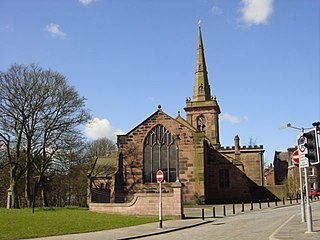
Prescot is a town and civil parish within the Metropolitan Borough of Knowsley in Merseyside, England. Within the boundaries of the historic county of Lancashire, it lies about eight miles (13 km) to the east of Liverpool city centre. At the 2001 Census, the civil parish population was 11,184. The population of the larger Prescot East and West wards at the 2011 census totalled 14,139. Prescot marks the beginning of the A58 road which runs through to Wetherby, near Leeds in West Yorkshire. The town is served by Prescot railway station and Eccleston Park railway station in neighbouring Eccleston.

Quiggins was an indoor market within Liverpool city centre. The market, which was home to many small 'alternative' stores, was located in adjacent three warehouse buildings on a site between School Lane, Peters Lane and College Lane. The main entrance was through the 1866 Palatine Building. Although Quiggins markets existed at several locations within Liverpool, these premises were the most well known in the city.
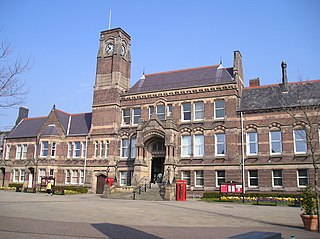
The Metropolitan Borough of St Helens in Merseyside, North West England, is named after its largest town, St Helens, and also includes Earlestown, Rainhill, Eccleston, Clock Face, Haydock, Billinge, Rainford and Newton-le-Willows.
The Natural Environment Research Council (NERC) is a British research council that supports research, training and knowledge transfer activities in the environmental sciences.
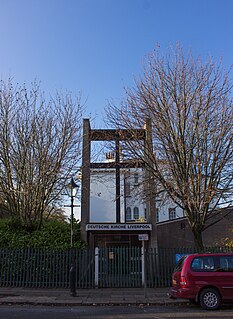
The German Church in Liverpool is in Bedford Street South/ Canning Street and is part of the German speaking churches of North England.
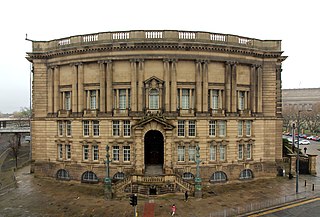
The College of Technology and Museum Extension in Byrom Street, Liverpool, England, was built between 1896 and 1901, the architect was Edward William Mountford. The building was constructed to provide a new College of Technology and an extension to the museum. The college occupied the lower levels and the museum the upper levels. Bomb damage led to some reconstruction work in the 1960s. The building is Grade II* listed.

The National Oceanography Centre Southampton (NOCS) is a centre for research, teaching, and technology development in Ocean and Earth science. NOCS was created in 1995 jointly between the University of Southampton and the UK Natural Environment Research Council and is located within the port of Southampton at a purpose-built dockside campus with modern facilities. In 2010 the University and NERC components demerged, and the NERC-managed component became the National Oceanography Centre. The two components of NOCS continue close collaboration through the jointly run Graduate School, shared research facilities and laboratories, complementary research groups, and many joint research grants and publications. The University component “Ocean and Earth Science, National Oceanography Centre Southampton” (OES) is part of the Faculty of Environmental and Life Sciences, (FELS). It was ranked 46th in the world for Earth and Marine Sciences by the QS World University Rankings in 2019.
The National Oceanography Centre (NOC) is a marine science research and technology institution based on two sites in Southampton and Liverpool, United Kingdom. It is the UK’s largest institution for integrated sea level science, coastal and deep ocean research and technology development.
David John Carson is a climatologist. He has been director of the Hadley Centre, director of Numerical Weather Prediction at the UKMO, and was director of the World Climate Research Programme from 2000-2005.
Central is a Liverpool City Council ward in the Liverpool Riverside Parliamentary constituency. The population at the 2011 census was 20,340. It was formed for the 2004 municipal elections from the former Abercromby, Everton and Smithdown wards. It contains the majority of the city centre but also includes Kensington Fields in Kensington to the east and the Marybone/Holy Cross community in Vauxhall. The ward includes the longstanding city centre community around the Bullring, as well as many new city centre apartments. Furthermore, the ward contains the Pier Head and the two larger universities; the University of Liverpool and Liverpool John Moores University.

The former Proudman Oceanographic Laboratory (POL) is based in Brownlow Street, Liverpool, England. In April 2010, POL merged with the National Oceanography Centre, Southampton (NOCS) to form the National Oceanography Centre. The Liverpool laboratory's scientific research focuses on oceanography encompassing global sea-levels and geodesy, numerical modelling of continental shelf seas and coastal sediment processes. This research alongside activities of surveying, monitoring, data management and forecasting provides strategic support for the wider mission of the Natural Environment Research Council.

Wavertree Playground, also known locally as The Mystery, was one of the first purpose-built public playgrounds in the United Kingdom. It is based in the Wavertree area of Liverpool, England.

Thingwall House was a Jacobethan manor house built in 1869 by Henry Arthur Bright, the shipping magnate, and was originally known as Ashfield. It is set on a 4.8-acre (19,000 m2) site in the district of Knotty Ash, Liverpool, England. It should not be confused with Thingwall Hall, a local stately home just a few minutes walk further south.
The University of Newcastle upon Tyne Faculty of Science, Agriculture and Engineering (SAgE) is a faculty of Newcastle University. It was established in the city of Newcastle upon Tyne as the College of Physical Science in 1871, for the teaching of physical sciences, and was part of Durham University. It existed until 1937, when it joined the College of Medicine to form King's College, Durham.

The British Oceanographic Data Centre (BODC) is a national facility for looking after and distributing data about the marine environment. BODC is the designated marine science data centre for the United Kingdom and part of the National Oceanography Centre (NOC) — primarily at its facility in Liverpool, with small number of its staff in Southampton. The centre provides a resource for science, education and industry, as well as the general public.
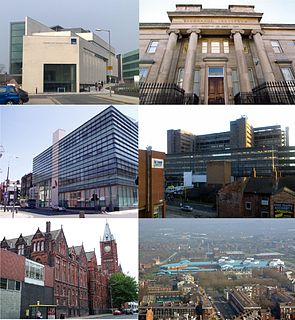
The "Knowledge Quarter" in Liverpool, England is a modern term in business given to the vicinity of Liverpool city centre that focuses heavily on the education, knowledge and research sectors.
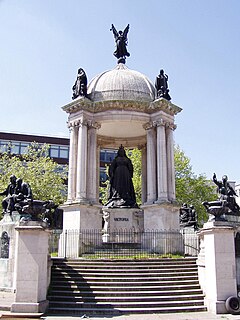
The Queen Victoria Monument is a large neo-Baroque or Beaux-Arts monument built over the former site of Liverpool Castle at Derby Square in Liverpool.

RRS Sir David Attenborough is a research vessel owned by the Natural Environment Research Council, to be operated by the British Antarctic Survey for the purposes of both research and logistic support. In this, the ship is intended to replace a pair of existing vessels, RRS James Clark Ross and RRS Ernest Shackleton. The vessel is named after broadcaster and naturalist Sir David Attenborough.
The Centre for Environmental Data Analysis (CEDA) is a United Kingdom organisation that serves the environmental science community by provision of data centres, data analysis, data access and research project participation.

The Department of Earth and Environmental Sciences at The University of Manchester is one of the oldest earth and environmental science departments in the UK. The Department takes roughly 100 new undergraduates and 140 postgraduates each year, and employs 90 members of academic staff, 41 postdoctoral researchers, 27 technical staff and 20 administrative staff.













